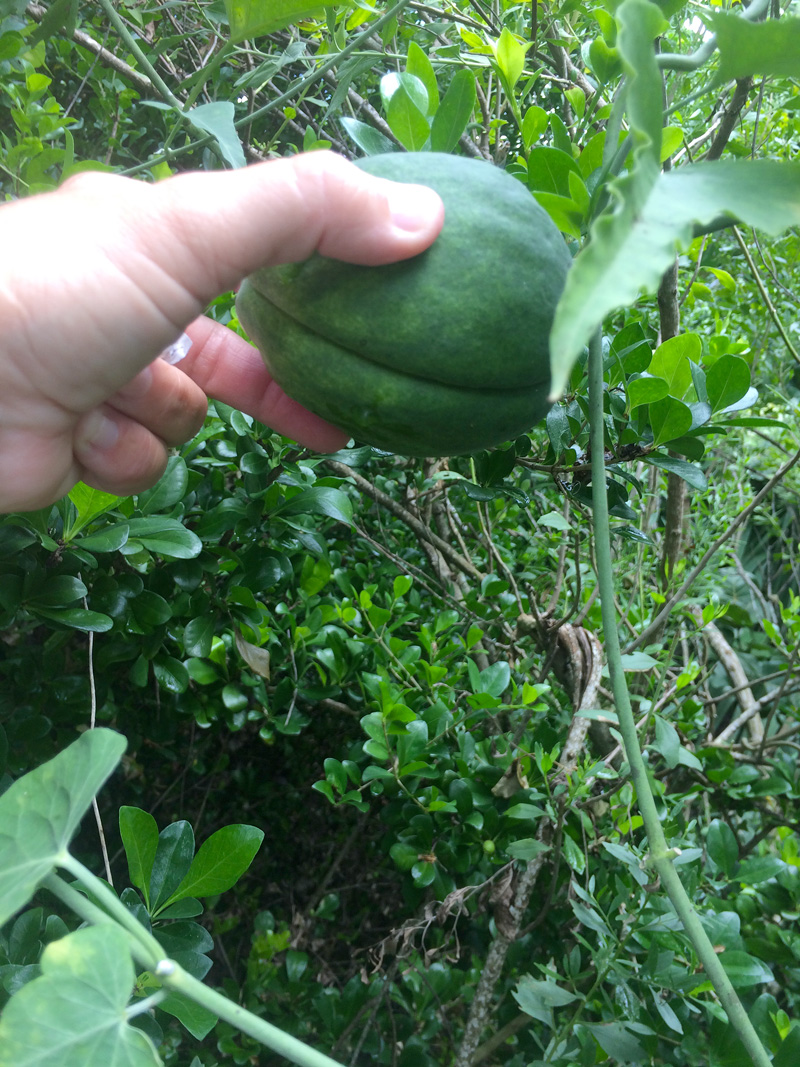
Barbie Martz (Class of 2012) sent the photo above of a mystery fruit and vine that she took near Wabasso Beach. It is latexplant (Araujla odorata), also known as latex vine, strangler vine, and white milkweed vine. Technically, it is a liana, a tropical woody vine.
This plant is native to Brazil, Bolivia, Argentina, Paraguay, and Uruguay, where it is said to be widespread and common. There, aboriginal people cultivate the plant for food. Uses vary by ethnic group. Most commonly, the fruit is boiled or roasted. The leaves also may be eaten raw, boiled or roasted. The stems are said to be a famine food.

Latexplant was first reported to be in Florida in 1957. Since then it has spread throughout central Florida. This plant is fast-growing and will engulf anything in its path, including a mature citrus tree, hence that common name of strangler vine. It kills mature citrus trees by shading them. Since it hardy from USDA Hardiness Zones 8 thorough 11, this plant has the potential to spread throughout the entire state and into Georgia & South Carolina.
The UF/IFAS Assessment of Non-Native Plants in Florida’s Natural Areas finds this plant to be “invasive” throughout the entire state. In the assessment, you will see this plant called by its prior botanical name, Morremia odorata. This genus name honors Belgian botanist Charles Morren (1807-1858), and the species name, odorata, refers to vanilla fragrance of the flowers.
The photographs of this plant in flowers were taken in 2012 at Pelican Island National Wildlife Refuge near their equipment storage building. This area is a former citrus grove, so the presence of this plant there was not too surprising. That year I described it in a presentation about perilous plants found in citrus groves for Center for Agricultural Sustainability for citrus inspectors from the Florida Department of Agriculture and Consumer Services Division of Plant Industry

Its leaves are opposite, grey-green leaves, pubescent (fuzzy), and held in pairs. New leaves are cordate (heart-shaped), and older leaves are haste (spearhead-shaped). Its stems contain a milky sap, as is typical of plants in the dogbane family, Apcocynaceae, giving rise to the common names latexplant and latex vine.
The latexplant flowers in the spring, summer, and fall. Its attractive, star-shaped flowers are greenish-white and have 5 petals. Its fruits are green when unripe and ripen to be tan or brown. Mature fruits are about 5-6″ long and 3-4″ and resemble an avocado in shape. Each fruit contains hundreds of seeds, each outfitted with a tiny parachute (coma) and ready to spread upon the wind. Notice the avocado-like shape of the unripe fruit in Barbie’s photo below and the adjacent native plants, white indigo berry (Randia aculeata).

Monarch butterflies will feed on this plant, as you might guess from the common name white milkweed. This plant, however, is pernicious pest of citrus and restoration efforts at Pelican Island National Wildlife Refuge and, potentially, a future invader of natural areas. It also is a host plant for the papaya fruit fly (Toxotrypana curvicauda).
Remove this plant immediately, if you encounter it, even if the web of life is at work with attacking aphids and a predatory lady bug …

